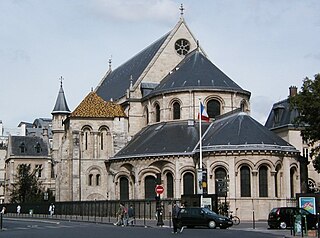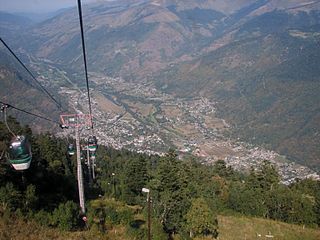Related Research Articles

Georges-Eugène Haussmann, commonly known as Baron Haussmann, was a French official who served as prefect of Seine (1853–1870), chosen by Emperor Napoleon III to carry out a massive urban renewal programme of new boulevards, parks and public works in Paris commonly referred to as Haussmann's renovation of Paris. Critics forced his resignation for extravagance, but his vision of the city still dominates central Paris.

A loanword is a word permanently adopted from one language and incorporated into another language without translation. This is in contrast to cognates, which are words in two or more languages that are similar because they share an etymological origin, and calques, which involve translation. Loanwords from languages with different scripts are usually transliterated, but they are not translated.

The 3rd arrondissement of Paris is one of the 20 arrondissements (districts) of the capital city of France. In spoken French, this arrondissement is colloquially referred to as the "troisième" meaning "third" in French. Its postal code is 75003. It is governed locally together with the 1st, 2nd and 4th arrondissement, with which it forms the 1st sector of Paris.

The Bois de Boulogne is a large public park located along the western edge of the 16th arrondissement of Paris, near the suburb of Boulogne-Billancourt and Neuilly-sur-Seine. The land was ceded to the city of Paris by the Emperor Napoleon III to be turned into a public park in 1852.

Corsican immigration to Puerto Rico resulted in the 19th century from widespread economic and political changes in Europe that made life difficult for the peasant and agricultural classes in Corsica and other territories. The Second Industrial Revolution drew more people into urban areas for work, widespread crop failure resulted from long periods of drought, and crop diseases, and political discontent rose. In the early nineteenth century, Spain lost most of its possessions in the so-called "New World" as its colonies won independence. It feared rebellion in its last two Caribbean colonies: Puerto Rico and Cuba. The Spanish Crown had issued the Royal Decree of Graces of 1815 which fostered and encouraged the immigration of European Catholics, even if not of Spanish origin, to its Caribbean colonies.

Cauterets is a spa town, a ski resort and a commune in the Hautes-Pyrénées department and the region of Occitanie in south-western France.

Bagnères-de-Luchon, also referred to as just Luchon, is a commune and spa town in the Haute-Garonne department in the Occitanie region of south-western France.

Haussmann's renovation of Paris was a vast public works programme commissioned by Emperor Napoleon III and directed by his prefect of Seine, Georges-Eugène Haussmann, between 1853 and 1870. It included the demolition of medieval neighbourhoods that were deemed overcrowded and unhealthy by officials at the time; the building of wide avenues; new parks and squares; the annexation of the suburbs surrounding Paris; and the construction of new sewers, fountains and aqueducts. Haussmann's work was met with fierce opposition, and he was finally dismissed by Napoleon III in 1870; but work on his projects continued until 1927. The street plan and distinctive appearance of the centre of Paris today are largely the result of Haussmann's renovation.

A marron glacé is a confection, originating in northern Italy and southern France consisting of a chestnut candied in sugar syrup and glazed. Marrons glacés are an ingredient in many desserts and are also eaten on their own.
In 1749 a large-scale census and statistical investigation was conducted in the Crown of Castile. It included population, territorial properties, buildings, cattle, offices, all kinds of revenue and trades, and even geographical informations from each place. It was encouraged by king Ferdinand VI of Spain and his minister the Marquis of Ensenada, and is known today as the Catastro of Ensenada.

The rue Saint-Honoré is a street in the 1st arrondissement of Paris, France.

The Lautaret Alpine Garden is an alpine botanical garden located at 2100 metres altitude in the Col du Lautaret of the Dauphiné Alps, near Villar-d'Arêne, Hautes-Alpes, Provence-Alpes-Côte d'Azur, France. It is part of the List of Remarkable Gardens of France certified by the Ministry of Culture (France).

Avenida Las Américas, is a major thoroughfare in Ponce, Puerto Rico. Most of its length is signed as Puerto Rico Highway 163 (PR-163). The highway has both of its termini as well as all of its length entirely within the Ponce city limits. It runs west to east. As of 12 November 2010, the segment of this road from its intersection in the west with PR-2R to its intersection in the east with PR-12, officially became the Bulevar Luis A. Ferré. The segment from Avenida Hostos in the east to Carretera Pámpanos (PR-2R) in the west, the first segment built, was built in 1960.
Arnold "Noldi" Schreck was Swiss-Russian-Mexican classical architect and designer. Also an artist, painter and decorator, he became a citizen of Mexico. Schreck designed restaurants, residences, hotels, clubs, offices, shops, movie sets, ports and entire villages. His work is in Mexico, Europe, Africa, North America, and South America.

The Jardin des Champs-Élysées is a public park located in the 8th arrondissement of Paris. It occupies 13.7 hectares, and is located on both sides of the Avenue des Champs-Élysées between the Place de la Concorde on the east and the Rond-point des Champs-Élysées on the west and between Avenue Gabriel to the north and the Seine to the south. It includes within its boundaries the Grand Palais and the Petit Palais, as well as a theater and other buildings. It was one of the first parks in the city, laid out by André Le Notre in 1667, and was the site of the Paris International Exposition of 1855 and an important part of the Paris Universal Exposition of 1900, for which the Grand Palais and Petit Palais were created.

Blusas are Basque citizens who dress in the traditional clothes of the region and attend events in Vitoria-Gasteiz such as the Virgen Blanca Festivities. The blusas assemble in groups called cuadrillas, and their main role is to provide entertainment at these events.
References
- "Breve diccionario etimológico de la lengua española" by Guido Gómez de Silva ( ISBN 968-16-2812-8)